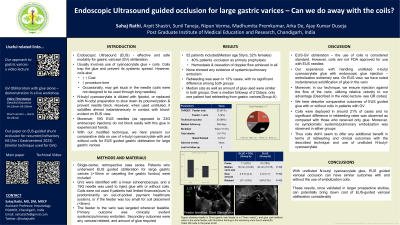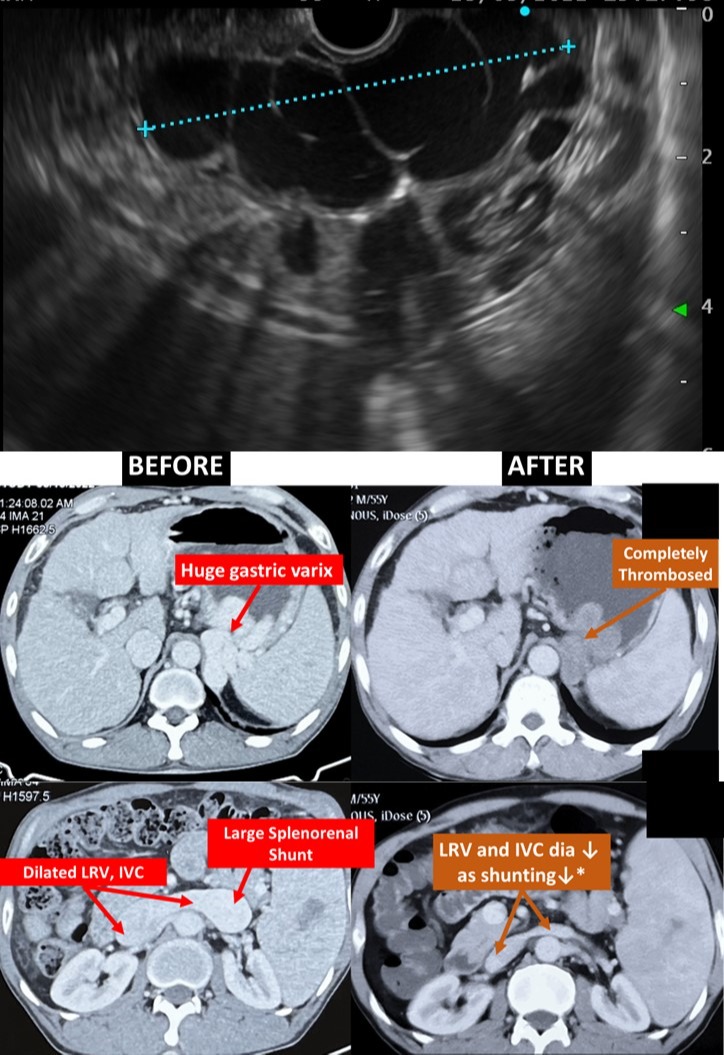Monday Poster Session
Category: Interventional Endoscopy
P2298 - Endoscopic Ultrasound Guided Occlusion for Large Gastric Varices – Can We Do Away With the Coils?
Monday, October 23, 2023
10:30 AM - 4:15 PM PT
Location: Exhibit Hall

Has Audio

Sahaj Rathi, MD, DM
PGIMER
Chandigarh, Chandigarh, India
Presenting Author(s)
Sahaj Rathi, MD, DM1, Arpit Shastri, MD1, Sunil Taneja, MD, DM1, Nipun Verma, MD, DM1, Arka De, MD2, Ajay Kumar. Duseja, MD2
1PGIMER, Chandigarh, Chandigarh, India; 2Postgraduate Institute of Medical Education and Research, Chandigarh, Chandigarh, India
Introduction: Endoscopic Ultrasound(EUS) is known to be effective and safe for gastric variceal(GV) occlusion. This usually involves use of cyanoacrylate glue in combination with embolization coils to trap the glue and prevent systemic spread of glue. However, the deployment of coils increases procedure time as well as expenses considerably.
Different cyanoacrylate glues have different solidification properties. N-butyl cyanoacrylate is often diluted with lipiodol to allow slow infusion, preventing needle block. However, when used undiluted, it solidifies nearly instantaneously when in contact with blood, and does not embolize distally. This is evident on endosonographic view. Moreover, 19G EUS needles (as opposed to 23G endoscopic injectors) do not block easily with this glue in experienced hands. We here present our comparative data on use of n-butyl cyanoacrylate with and without coils for EUS guided gastric obliteration for large gastric varices.
Methods: In this single-center retrospective case series, patients who underwent EUS guided obliteration for large gastric varices ( >20mm or carpeting the gastric fundus) with active bleeding, primary prophylaxis, or secondary prophylaxis were included. GV were identified with a linear echoendoscope, and a 19G needle used to inject glue with or without coils. Target was the feeder to the varix wherever identifiable. Primary outcome was clinically evident systemic/pulmonary embolism. Secondary outcomes were any variceal rebleed, and amount of glue required
Results: A total of 41 patients were included. Median age was 49 years, and 29% were females. 34% patients underwent occlusion as primary prophylaxis. Endoscopic hemostasis as well as complete cessation of doppler flow was achieved in all cases. None of the patients showed any evidence of systemic/pulmonary embolism
Rebleeding was seen in 17% cases (22% in coil+glue combination, 15% in glue-only groups, P=NS). Median size of varices (Coil+glue vs coils-only, median, range: 35mm(15-50mm), 30mm(15-75mm) P=NS) as well as amount of glue used (2.5ml(2-4ml), 2ml (1-7ml), P=NS) was similar in both groups. Over a median followup of 248 days, only one patient had rebleeding from gastric varices (Coil+Glue group)
Discussion: When using undiluted N-butyl cyanoacrylate glue, EUS guided variceal occlusion can have similar outcomes with and without the use of embolization coils. These results, once validated in larger prospective studies, can potentially bring down cost of EUS-guided variceal obliteration considerably

Disclosures:
Sahaj Rathi, MD, DM1, Arpit Shastri, MD1, Sunil Taneja, MD, DM1, Nipun Verma, MD, DM1, Arka De, MD2, Ajay Kumar. Duseja, MD2. P2298 - Endoscopic Ultrasound Guided Occlusion for Large Gastric Varices – Can We Do Away With the Coils?, ACG 2023 Annual Scientific Meeting Abstracts. Vancouver, BC, Canada: American College of Gastroenterology.
1PGIMER, Chandigarh, Chandigarh, India; 2Postgraduate Institute of Medical Education and Research, Chandigarh, Chandigarh, India
Introduction: Endoscopic Ultrasound(EUS) is known to be effective and safe for gastric variceal(GV) occlusion. This usually involves use of cyanoacrylate glue in combination with embolization coils to trap the glue and prevent systemic spread of glue. However, the deployment of coils increases procedure time as well as expenses considerably.
Different cyanoacrylate glues have different solidification properties. N-butyl cyanoacrylate is often diluted with lipiodol to allow slow infusion, preventing needle block. However, when used undiluted, it solidifies nearly instantaneously when in contact with blood, and does not embolize distally. This is evident on endosonographic view. Moreover, 19G EUS needles (as opposed to 23G endoscopic injectors) do not block easily with this glue in experienced hands. We here present our comparative data on use of n-butyl cyanoacrylate with and without coils for EUS guided gastric obliteration for large gastric varices.
Methods: In this single-center retrospective case series, patients who underwent EUS guided obliteration for large gastric varices ( >20mm or carpeting the gastric fundus) with active bleeding, primary prophylaxis, or secondary prophylaxis were included. GV were identified with a linear echoendoscope, and a 19G needle used to inject glue with or without coils. Target was the feeder to the varix wherever identifiable. Primary outcome was clinically evident systemic/pulmonary embolism. Secondary outcomes were any variceal rebleed, and amount of glue required
Results: A total of 41 patients were included. Median age was 49 years, and 29% were females. 34% patients underwent occlusion as primary prophylaxis. Endoscopic hemostasis as well as complete cessation of doppler flow was achieved in all cases. None of the patients showed any evidence of systemic/pulmonary embolism
Rebleeding was seen in 17% cases (22% in coil+glue combination, 15% in glue-only groups, P=NS). Median size of varices (Coil+glue vs coils-only, median, range: 35mm(15-50mm), 30mm(15-75mm) P=NS) as well as amount of glue used (2.5ml(2-4ml), 2ml (1-7ml), P=NS) was similar in both groups. Over a median followup of 248 days, only one patient had rebleeding from gastric varices (Coil+Glue group)
Discussion: When using undiluted N-butyl cyanoacrylate glue, EUS guided variceal occlusion can have similar outcomes with and without the use of embolization coils. These results, once validated in larger prospective studies, can potentially bring down cost of EUS-guided variceal obliteration considerably

Figure: Representative image of a large shunt occluded without coils
Disclosures:
Sahaj Rathi indicated no relevant financial relationships.
Arpit Shastri indicated no relevant financial relationships.
Sunil Taneja indicated no relevant financial relationships.
Nipun Verma indicated no relevant financial relationships.
Arka De indicated no relevant financial relationships.
Ajay Duseja indicated no relevant financial relationships.
Sahaj Rathi, MD, DM1, Arpit Shastri, MD1, Sunil Taneja, MD, DM1, Nipun Verma, MD, DM1, Arka De, MD2, Ajay Kumar. Duseja, MD2. P2298 - Endoscopic Ultrasound Guided Occlusion for Large Gastric Varices – Can We Do Away With the Coils?, ACG 2023 Annual Scientific Meeting Abstracts. Vancouver, BC, Canada: American College of Gastroenterology.
